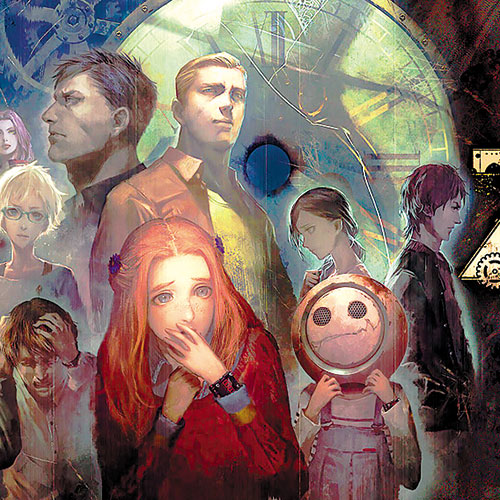A mind-bending adventure through a maze of death

By Javy Gwaltney | Game Informer Magazine
“Zero Time Dilemma”
Platform: 3DS | Vita | PC
Style: 1-Player Adventure
Publisher: Aksys Games
Developer: Spike Chunsoft
Rating: M, for Mature
The “Zero Escape” series has earned a reputation for inflicting mental anguish on players, combining the torturous mind games of “Saw” with “Choose Your Own Adventure” books to create an experience that puts players through the wringer. They are strange games that tackle complex theories about the paranormal and time travel, and refuse to break them down for easy understanding, but the challenge and peculiarities have attracted a cult following. “Zero Time Dilemma,” the third entry, retains those two key pillars while also serving as a more inviting and standalone title thanks to its focus on characters and its impressive non-linear structure.
The intro sequence quickly reveals the setup: The villain Zero, decked out in plague-doctor apparel, is keen on making his nine prisoners (divided into three teams of three) play twisted games to earn their survival. The prisoners are wearing bracelets that inject them with a drug that puts them to sleep and erases the last 90 minutes of their memory. Zero informs everyone that to escape, six of them must die. Each death reveals a passcode, and the final three survivors can use the passcodes to leave the facility, creating a scenario where it’s in the best interest of these teams to kill each other. This creates an enjoyable and tense situation that forces you to choose how each team leader is going to react to the situation.
From there, the narrative plays out in non-linear fashion, with you selecting a team and then a random snapshot from a “fragments” menu in order to play out a scene from somewhere in the game that features that team. You can’t tell where in the timeline you might be before you select that fragment and complete it. Fragments are usually composed of two stages: The escape phase has you trying to escape a room by solving intricate puzzles with objects that have been placed in the area, while the decision phase has you making a critical choice that results in a branch in the narrative. Your character might pull a lever causing the entire team to plummet to their deaths, resulting in an ending for that team. If you refrain from pulling the lever, maybe you are allowed to leave the room. The whole game is like this, with you jumping back and forth between teams and playing sections out of order.
This structure is confusing. It shouldn’t work, but it does in ways that are constantly surprising and a joy to discover. Even earning a “bad” ending feels like you’re making progress because of how the story is presented and how easy it is to dive back to a critical choice and see how it can play out differently. I can play through one fragment, screw up and watch my team of idiots perish, and rewind and undo the mistake. Instead of making my choices feel meaningless, it makes me feel powerful, and I’m constantly goaded by the little blank spots on my fragment flowcharts to play through every scenario to see every ending and possibility.
“Zero Time Dilemma” works best when it’s at its weirdest, forcing players down strange narrative alleyways or making them scratch their heads over vexing puzzles. That said, a number of small aggravations diminish the charm. The escape-the-room phases have you searching the environment for necessary objects, but sometimes they are unreasonably tiny. You would never find them unless you just happen to be tapping over the area where they are, which is a bummer; I often wondered whether I was missing an integral piece of the puzzle without realizing it. And while this third game in a series with complex lore does a commendable job as a standalone title, still a few conversations between characters returning from earlier games end up being little more than plot summaries used to help catch new players up to speed. Trying to help newcomers out isn’t a bad idea, but the execution here is poor, with characters suddenly shifting from personal conversations into dull exposition. The silver lining is that these conversations contain nods to the previous games and work well as fan service — even if they bring the pacing to a halt occasionally.
These aggravations do little to damage “Zero Time Dilemma” when it lets you take control of this interactive story in engaging and memorable ways. The final chapter of the “Zero Escape” series is an excellent horror adventure both for fans and newcomers, allowing them to be storytellers in addition to players, defying time and fate to create their own twisted labyrinths.











